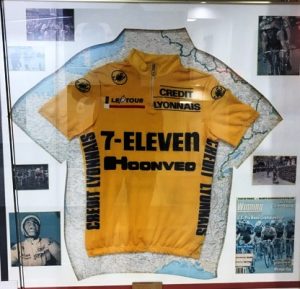Velodrome Aero Testing an Ironman Triathlon Setup

I recently posted my test results from my trip with Marty to use the cutting edge Alphamantis Track Aero System (TAS) at the Mattamy National Cycling Center in Milton, Ontario. The TAS provides real-time aerodynamic data to the tester while you’re riding, which facilitates faster on-the-spot results and decisions compared to my normal field testing routine. While I detailed my velodrome aero testing in a previous article, we’ll cover Marty’s testing experience and results here. Missy Erickson from ERO Sports provided the testing services and was great.
Baseline Velodrome Aero Testing Setup for Ironman
At Fit Werx, we’ve refined Marty’s position over the years with an on-going fit process and power meter based field aero testing that tweaks things as Marty integrates fitness and technique improvements into his riding. His last major event was Ironman Mont Tremblant in 2015 and he is planning another Ironman in the future. His Ironman position has to be comfortable and sustainable for the long training hours, but it also needs to be aero and efficient so he gets the most speed possible for his race day effort. Marty needs a position that makes digesting nutrition easy, and allows him to run effectively off the bike. He also needs to keep adequate nutrition on the bike. For this reason, we installed his race day hydration for all testing.
 Marty tested on his new Cervelo P5X equipped with SRAM eTap components and Enve 7.8 wheels. While he’ll run faster rolling tires and tubes on race day (likely Continental Supersonic or TT 700×23 tires and latex tubes), we tested with Continental 4000S tires and butyl tubes. The only data we were interested in was comparative aerodynamic data for setup changes, so the tires used in testing do not matter.
Marty tested on his new Cervelo P5X equipped with SRAM eTap components and Enve 7.8 wheels. While he’ll run faster rolling tires and tubes on race day (likely Continental Supersonic or TT 700×23 tires and latex tubes), we tested with Continental 4000S tires and butyl tubes. The only data we were interested in was comparative aerodynamic data for setup changes, so the tires used in testing do not matter.
This was Marty’s first time riding a velodrome. I can speak from experience about how intimidating it is as a first timer. We rolled around the apron for a few laps before he confidently started riding on the banking. Before he knew it, he was cruising around the banking like a natural.
Once Marty had his “sea legs” beneath him, it was time to roll the testing. Marty’s first test was his Ironman Mont Tremblant 2015 position on the new Cervelo P5X – this became baseline. He used a Bell Javelin helmet, which had field tested fastest, and a sleeveless Fit Werx one-piece tri suit. His arms and legs were unshaven, only because he planned to shave them before his final test. Sadly, we ran out of time to do this test, but we suspect that we would have seen lower CdA values given recent aero testing for shaved legs data.
I asked Missy what rolling resistance (Crr) value the TAS uses to compute CdA (aerodynamic drag) and found out 0.002 is usually used. The Continental 4000S tires and butyl tubes have a higher Crr than 0.002, so it is worth pointing out that this extra resistance will get lumped into the reported CdA values. This all being said, all that really matters for figuring out what is most aero for Marty is the differences in CdA values across the set-ups tested. We used the same tires in all tests, so they won’t change the relative values.
The Test Setups
Setup 1 – Baseline/Bell – CdA 0.2804
Setup 2 – Setup 1 with Aerobar pads angled inward – CdA 0.2802
Setup 3 – Same as setup 2, but with tips of extensions rotated in – CdA 0.2876
Setup 4 – Same as setup 2, but with front end raised 2cm – CdA 0.2815
Setup 5 – Same as setup 2 , but with armpads raised 1cm – CdA 0.2839
Setup 6 – Same as setup 2 but with Giro Aerohead helmet – 0.2827
Setup 7 – Same as setup 2, but with Louis Garneau P-09 helmet – 0.2842
Discussion and Velodrome Aero Test Conclusions
 Right out of the gate it was evident that Marty’s position wasn’t going to improve by much. This was fine as it was reassuring and meant we could focus on equipment variables for him. We tried a lower and longer position in the past, and both were slightly more aero, but while those positions worked for short course triathlons they were unsustainable for Ironman. A lower bar height was not worth testing again for these reasons.
Right out of the gate it was evident that Marty’s position wasn’t going to improve by much. This was fine as it was reassuring and meant we could focus on equipment variables for him. We tried a lower and longer position in the past, and both were slightly more aero, but while those positions worked for short course triathlons they were unsustainable for Ironman. A lower bar height was not worth testing again for these reasons.
Setup 2 involved angling the elbow pads so his elbow would turn out slightly and his wrists turned in. The width between the elbow pads did not change from baseline. In setup 3 we went with that result and Marty put his hands together over the ends of the extensions. This increased drag so we went back to Setup 2 for further testing.
Setup 4 raised his armpad height 2cm (which is very easy to adjust on the new P5X) and we saw a surprisingly minimal CdA increase. We then tried splitting the difference at just 1cm higher in Setup 5 from baseline. Also surprising, this actually increased CdA from 2cm higher. A number of factors can influence a small change like that. However, the bottom line is that there is a slight penalty for Marty to go higher and we know that his current position is comfortable and sustainable. It is nice to know that his aerobar height is in the sweet spot for him and it is also nice to know that if a higher bar position is desired, there is very little penalty.
Setup 6 tested the new Giro Aerohead helmet. This helmet tests very fast for many riders. The Aerohead was on many time trialists and track cyclists at the Rio Olympics. I personally field tested this helmet against my Bell Javelin. While the Bell Javelin is also faster for me, the Giro Aerohead is the second fastest helmet I’ve ever tested. Marty had similar results.
Setup 7 tests the Louis Garneau P-09 helmet. Marty field tested this helmet before, but couldn’t detect a difference from the Bell Javelin. In our velodrome test, the P-09 tested slower than the Javelin for him. Both the Giro Aerohead and the Louis Garneau P-09 were slower than the Bell Javelin for Marty. The Bell is also more comfortable for Marty, making it an easy decision to stick with it.

Sadly, we did not have time to use velodrome aero testing to find out how much shaving Marty’s arms and legs matters. Given it’s the middle of winter and Marty’s hirsute legs and arms are at their maximum, shaving would have likely been the biggest drag reduction of the velodrome aero testing we did.
I spent some time calculating what Marty’s true Crr with the Continental GP4000S tires would have been on that track and its impact on his reported CdA values. Fortunately he ran a range of different speeds on the track. Using some regression it appears his Crr value is around 0.004 using these tires. Taking this adjustment into account, his CdA values all drop under 0.26 which is inline with what we’ve tested in the field. At his 22mph testing speed, shaved arms and legs would likely reduce his CdA to under 0.25. A great number for a comfortable and sustainable Ironman position.
The Takeaway of Marty’s Velodrome Aero Testing
The biggest take home for Marty is the validation that his current position is optimized for Ironman. It is hard to put a value on quantifiably knowing there is as little compromise as possible. Also, knowing that the aerobars could go up 2cm higher with little to no aero penalty is good for him to have in his back pocket. The Bell Javelin remaining a great choice for him is also very reassuring.
From here, his next Ironman will come down to training, preparation and experience. The velodrome aero testing allows Marty to train and race with the confidence of knowing his equipment is not holding back his performance.
If you have questions about field or velodrome based testing or what we have learned about equipment and positioning aerodynamics through our testing, post a comment, contact me or schedule a fitting.
